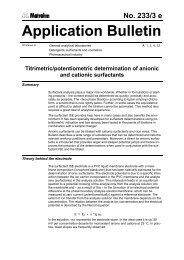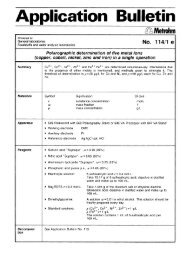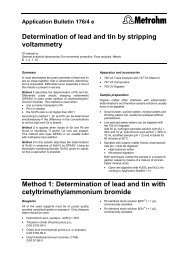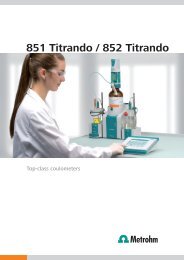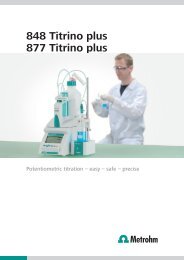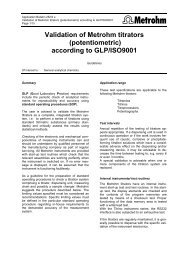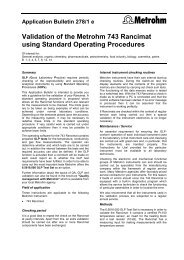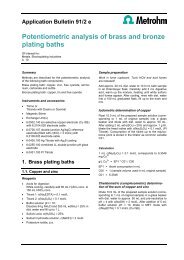Voltammetric Determination of Iron - Metrohm
Voltammetric Determination of Iron - Metrohm
Voltammetric Determination of Iron - Metrohm
- No tags were found...
You also want an ePaper? Increase the reach of your titles
YUMPU automatically turns print PDFs into web optimized ePapers that Google loves.
Application Bulletin 317/1 e<strong>Voltammetric</strong> <strong>Determination</strong> <strong>of</strong> <strong>Iron</strong>Page 5/13Remarks• As both triethanolamine and potassium bromateare contaminated with iron it is essential to determinea blank value for the reagents.• When measuring the blank value a shoulder appearson the iron signal at approx. -0.8 V. After theaddition <strong>of</strong> a foreign ion (e.g. Pb 2+ ) this shoulderdisappears again.• Detection limit: β(Fe) = 2 µg/L• Limit <strong>of</strong> quantification: β(Fe) = 6 µg/L.• Linear range: up to 200 µg/L• For higher iron concentrations it is possible toprepare the supporting electrolyte without potassiumbromate. This avoids the catalytic enhancementwith the result that the sensitivity <strong>of</strong> the determinationis reduced by a factor <strong>of</strong> about 40.• <strong>Determination</strong> <strong>of</strong> seawaterBecause <strong>of</strong> the increased concentrations <strong>of</strong> calciumand magnesium ions a modified supportingelectrolyte must be used for seawater:Supportingelectrolyte forseawaterc(NaOH) = 5 mol/Lc(C 6 H 8 O 7 ) = 1.56 mol/Lc(KBrO 3 ) = 0.1 mol/Lc(C 6 H 15 NO 3 ) = 0.05 mol/L15 g citric acid are dissolved in15 mL ultrapure water in a 50mL volumetric flask. 25 mLNaOH, 0.373 g triethanolamineand 0.835 g KBrO 3 are added.After cooling to room temperaturethe solution is made up tothe mark with ultrapure water.Caution: the solution becomesvery hot!The citrate contained in the solution complexesthe calcium and magnesium ions present. The pH<strong>of</strong> the measuring solution must be between 12.0and 12.4 in order to obtain usable signals. If thepH is too low no signal can be measured. If the pHis above 12.4 then calcium and magnesium precipitateas hydroxides.Measuring solution10 mL seawater sample+ 2 mL supporting electrolyte for seawaterpH = 12…12.4This modified electrolyte can be used for both Method1 and Method 2.Interference from other metal ions• Possible interferences to the peak <strong>of</strong> β(Fe 3+ ) =100 µg/L have been investigated for the followingions under the measuring conditions given for Method2. If nothing to the contrary is mentioned,tests have been carried out at an excess <strong>of</strong> 200:1.Element RemarksAl 3+No interferenceBi 3+ No interference, peak at -0.64 V,tested up to 600:1Cd 2+ No interference, peak at -0.68 V,tested up to 500:1Co 2+No interferenceCr 3+No interferenceCr 6+Interference by peak at -1.0 VCu 2+No interference,Tested up to 500:1In 3+No interference up to a ratio <strong>of</strong>10:1. At concentrations β(In 3+ ) >1 mg/L interference by a peak at-1.0 V and a further peak at -1.25 Vis observed.Mn 2+ From a concentration <strong>of</strong> β(Mn 2+ ) =20 mg/L signals occur at -0.12 V;-0.29 V, interference by peak at-1.2 V.Ni 2+Pb 2+Sb 3+Sb 5+Se 4+Se 6+Sn 2+Sn 4+No interferenceNo interference, peak at -0.67 VNo interferenceNo interference. peak at -0.12 VNo interferenceNo interferenceNo interferenceNo interferenceZn 2+ No interference, peak at -1.38 V,tested up to 1000:1Li +K +Ca 2+Mg 2+Na +No interferenceNo interferenceNo interference, precipitate fromapprox. β(Ca 2+ ) = 20 mg/L electrolytefor seawaterNo interference, precipitate fromapprox. β(Mg 2+ ) = 0.1 g/L electrolytefor seawaterNo interference





